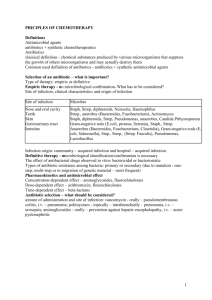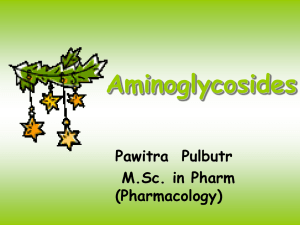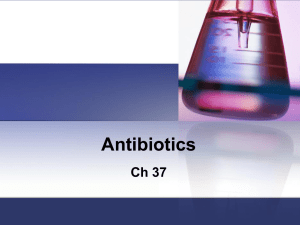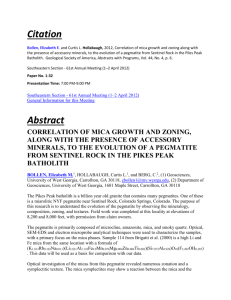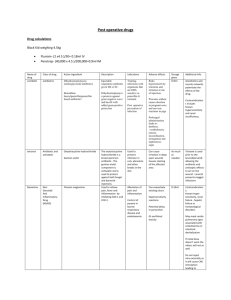Antimicrobial agents - antibiotics + synthetic chemiotherapeutics
advertisement
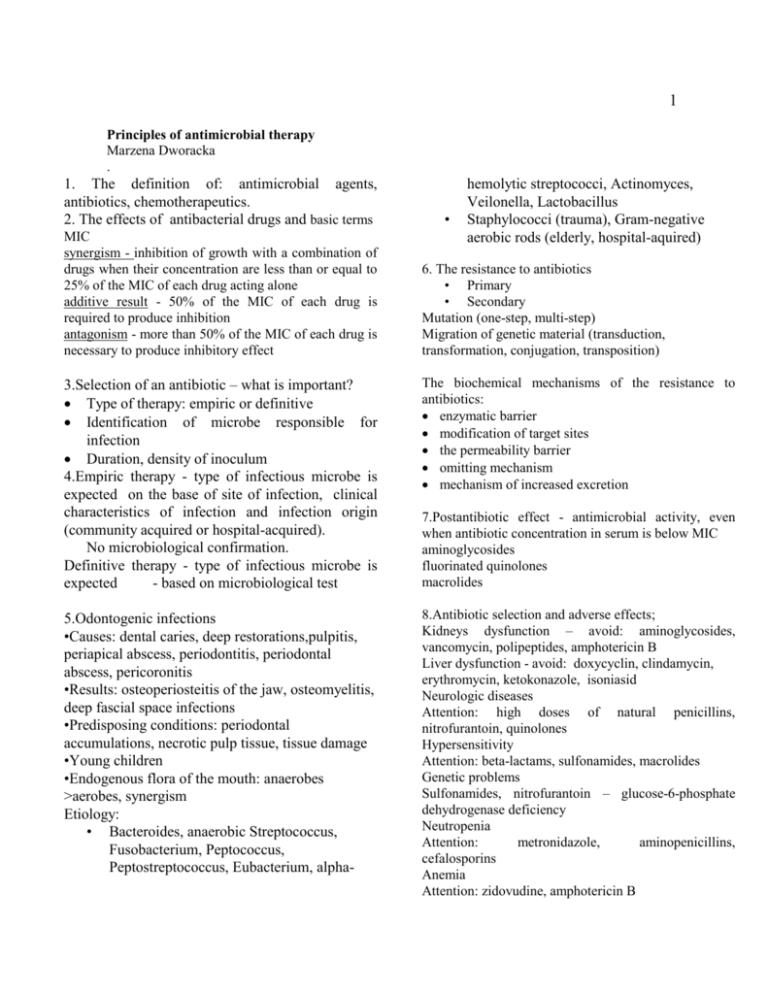
1 Principles of antimicrobial therapy Marzena Dworacka . 1. The definition of: antimicrobial agents, antibiotics, chemotherapeutics. 2. The effects of antibacterial drugs and basic terms MIC synergism - inhibition of growth with a combination of drugs when their concentration are less than or equal to 25% of the MIC of each drug acting alone additive result - 50% of the MIC of each drug is required to produce inhibition antagonism - more than 50% of the MIC of each drug is necessary to produce inhibitory effect • hemolytic streptococci, Actinomyces, Veilonella, Lactobacillus Staphylococci (trauma), Gram-negative aerobic rods (elderly, hospital-aquired) 6. The resistance to antibiotics • Primary • Secondary Mutation (one-step, multi-step) Migration of genetic material (transduction, transformation, conjugation, transposition) 3.Selection of an antibiotic – what is important? Type of therapy: empiric or definitive Identification of microbe responsible for infection Duration, density of inoculum 4.Empiric therapy - type of infectious microbe is expected on the base of site of infection, clinical characteristics of infection and infection origin (community acquired or hospital-acquired). No microbiological confirmation. Definitive therapy - type of infectious microbe is expected - based on microbiological test The biochemical mechanisms of the resistance to antibiotics: enzymatic barrier modification of target sites the permeability barrier omitting mechanism mechanism of increased excretion 5.Odontogenic infections •Causes: dental caries, deep restorations,pulpitis, periapical abscess, periodontitis, periodontal abscess, pericoronitis •Results: osteoperiosteitis of the jaw, osteomyelitis, deep fascial space infections •Predisposing conditions: periodontal accumulations, necrotic pulp tissue, tissue damage •Young children •Endogenous flora of the mouth: anaerobes >aerobes, synergism Etiology: • Bacteroides, anaerobic Streptococcus, Fusobacterium, Peptococcus, Peptostreptococcus, Eubacterium, alpha- 8.Antibiotic selection and adverse effects; Kidneys dysfunction – avoid: aminoglycosides, vancomycin, polipeptides, amphotericin B Liver dysfunction - avoid: doxycyclin, clindamycin, erythromycin, ketokonazole, isoniasid Neurologic diseases Attention: high doses of natural penicillins, nitrofurantoin, quinolones Hypersensitivity Attention: beta-lactams, sulfonamides, macrolides Genetic problems Sulfonamides, nitrofurantoin – glucose-6-phosphate dehydrogenase deficiency Neutropenia Attention: metronidazole, aminopenicillins, cefalosporins Anemia Attention: zidovudine, amphotericin B 7.Postantibiotic effect - antimicrobial activity, even when antibiotic concentration in serum is below MIC aminoglycosides fluorinated quinolones macrolides 2 Older persons: attention!!! tetracyclines, aminoglycosides, vancomycin, quinolones Neonates and infants tetracyclines, quinolones, sulfonamides!!! Pregnancy and lactation: acceptable –natural penicillins, aminopenicillins, 1st generation cephalosporins, erythromycin, contraindicated: quinolones, tetracyclines, sulfonamides 9.Antibiotic selection and distribution • Proteins in plasma: hipoalbuminemia (hepatic failure, nephrotic syndrome) – Sulfonamides? Aminoglycosides? • Leukocytosis (leukemia), anemia – Aminoglycosides? • Bones infection. Clindamycin? Aminoglycosides? • Antibiotic selection and topical factorsematoma, abscessus, gastic acid pH 10.Antibiotics combinations Bactericidal+bactericidal = synergism or indifference, rare antagonism Bacteriastatic+bacteriastatic = additive result, rare antagonism or synergism Bactericidal+bacteristatic = additive result or antagonizm (higher susceptablity to bacteriacidal) or synergism (higher susceptability to bacteriastatic) synergism: MICA+B 25%MICA i MICA+B 25%MICB Drug A increases susceptablity of microbes to drug B Additive effect: MICA+B = 50%MICA i MICA+B = 50%MICB Drug A and B act independent each on other Antagonism: MICA+B > 50%MICA i MICA+B > 50%MICB Drugs A and B act independent each on other Indications for the clinical use of antibiotics combinations When? • treatment of mixed infections , long-term antibiotic therapy, empiric therapy Why? • resistance prevention, synergism achievement, doses reduction 11.Principles for prescribing antimicrobials: •Use only when there is an indication •Use only when the risk/benefit balance is favorable •It is not a substitute for establishing adequate drainage •Choose the narrowest spectrum drug that will be effective •Adequate dose •Appropriate duration •Choose the drug with the fewest side effects •Choose the least expensive agent •Laboratory identification if necessary •Avoid resistance: too long use and/or use of suboptimal doses 12. Prophylaxis against sytemic infections For whom (American Dental Association? Antibiotic prophylaxis recommendations exist for two groups of patients: • those with heart conditions that may predispose them to infective endocarditis • those who have a prosthetic joints and may be at risk for developing hematogenous infections at the site of the prosthetic (not routinely). The use of preventive antibiotics before certain dental procedures is reasonable for patients with: • prosthetic cardiac valve or prosthetic material used for cardiac valve repair • a history of infective endocarditis • a cardiac transplant that develops cardiac valvulopathy • the following congenital (present from birth) heart disease: unrepaired cyanotic congenital heart disease, including palliative shunts and conduits a completely repaired congenital heart defect with prosthetic material or device, whether placed by surgery or by catheter intervention, during the first six months after the procedure any repaired congenital heart defect with residual defect at the site or 3 adjacent to the site of a prosthetic patch or a prosthetic device (that inhibit endothelialization) Prophylaxis is recommended for all dental procedures that involve manipulation of gingival tissue or the periapical region of the teeth, or perforation of the oral mucosa. F.e.: Dental extractions Periodontal procedures Prophylactic cleaning of teeth or implants where bleeding is anticipated Dental implant placement Endodontic instrumentation or surgery beyond the root apex Subgingival placement of antibiotic fibers or strips Initial placement of orthodontic bands (not brackets) Intraligamentary local anesthetic injections Antibiotic prophylaxis not recommended: • • • • • uncomplicated atrial septal defects surgically repaired atrial or ventricular septal defects or ductus arteriosus and with complete healing physiologic heart murmurs coronary artery surgery implanted cardiac peacemakers or defibrillators without additional cardiac defects (exception – prior incision and drainage of oral abscessus) and • • • • • • shedding of primary teeth restorative dentistry intracanal endodontic treatments placement of removable prosthodontic or orthodontic appliances postoperative suture removal orthodontic appliance adjustment • • • • taking of intraoral radiographs or impressions topical fluoride applications nonligamentary local anesthetic injection antesthetic injection through nonifectected tissue Regimens for the prevention of bacterial endocarditis • standard amoxicillin 2,0 (children 50 mg/kg) orally 1 h before procedure • patients anable to take/absorb oral medication ampicillin 2,0 i.m. or i.v. (children 50mg/kg) or ceftriaxone or cephazolin 1,0 i.m. or i.v. (children 50mg/kg) • patients allergic to penicillins cephalexin 2,0 orally or clindamycin 600 mg orally or azithromycin or clarithromycin 500 mg (children 15 mg/kg) • patients allergic to penicillins and unable to take medications orally cephazolin or ceftriaxone 1,0 i.m. or i.v. (children 50mg/kg) or clindamycin 600 mg i.m. or i.v. (children 20mg/kg) 13.Superinfections The appearance of bacteriological and clinical evidence of a new infection during chemotherapy of a primary one. • changes in the normal microbial population of the intestinal, upper respiratory and genitourinary tract • when broad-spectrum agents are used
